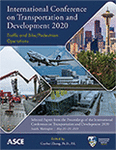International Conference on Transportation and Development 2020
Queue Lengths Produced by the New Synchronized and Milwaukee B Interchanges Compared to Existing Designs
Publication: International Conference on Transportation and Development 2020
ABSTRACT
The main objective of this research was to estimate the maximum queue lengths generated by two new designs, including synchronized and Milwaukee B interchanges, in comparison to four existing designs. The methodology consisted of three main parts: (1) building a simulation model calibrated to the geometric features of 30 existing service interchanges; (2) running over 1000 simulation tests using VISSIM and Synchro; and (3) conducting two-way analyses of variance (ANOVAs) on simulation outcomes. Queue lengths were measured for many combinations of traffic volume, turning traffic percentage, traffic distribution, and traffic composition. Based on the results, the Milwaukee B design had the shortest mean queue lengths among all the interchanges considered in this study. The Milwaukee B had queue lengths averaging about 68% shorter than a parclo B interchange, which was the design with the shortest mean queue length among conventional designs. The synchronized and the DDI had similar mean queue lengths.
Get full access to this article
View all available purchase options and get full access to this chapter.
REFERENCES
A Policy on Geometric Design of Highways and Streets. (2018). American Association of State Highway and Transportation (AASHTO), Washington D.C.
Bonneson, J. A. (1992). “Operational Efficiency of the Single-Point Urban Interchange.” ITE Journal.
Chlewicki, G. (2003). “Variations of the Diverging Diamond Interchange.” Second Urban Street Symposium of Transportation Research Board (TRB), Anaheim, California.
Eamon, C., and Siavashi, S. (2018). Developing Representative Michigan Truck Configurations for Bridge Load Rating (No. SPR-1640). Michigan Department of Transportation, Research Administration.
Esawey, M. E., and Sayed, T. (2012). “Analysis of unconventional arterial intersection designs (UAIDs): State-of-the-art methodologies and future research directions.” Transportmetrica, 1–36.
Eustace, D., and Ponnada, S. (2012). “L&D Manual Turn Lane Storage Validation/Update.” Ohio Department of Transportation,.
Eyler, D. (2005). “Arterial Interchange.” Journal of the Transportation Research Board, No. 1912, Transportation Research Board of the National Academies, Washington D.C., pp. 65–71.
Fitzpatrick, K., Schneider, W., and Park, E. (2006). “Predicting Speeds in an Urban Right-Turn Lane.” Journal of Transportation Engineering, 132(3).
Ghanbarikarekani, M., Sohrabi, S., and Vefghi, A. (2016). “Optimization of signal timing of intersections by internal metering of queue time ratio of vehicles in network scale.” PROMET-Traffic&Transportation, 28(3), 205-214.
Khan, T., and Anderson, M. (2016). “Evaluating the Application of Diverging Diamond Interchange in Athens, Alabama.” International Journal for Traffic and Transport Engineering, 6(1), 38-50.
Mehrara Molan, A. (2017). “Evaluation of Milwaukee B and Synchronized as New Service Interchange Designs.” Ph.D. Dissertation, Wayne State University, Detroit.
Mehrara Molan, A. (2017). “Evaluation of Milwaukee B and Synchronized as New Service Interchange Designs.” Ph.D. dissertation. Wayne State University, Detroit, 2017.
Mehrara Molan, A., and Hummer, J. (2017). “Safety Analysis of the New Synchronized and Milwaukee B Interchanges in Comparison to Existing Designs.” Accident Analysis and Prevention, Elsevier, Vol 109 (December), 29-35.
Mehrara Molan, A., and Hummer, J. (2018a). “Travel Time Evaluation of Milwaukee B and Synchronized as New Interchange Designs.” Journal of Transportation Engineering, 144(2).
Mehrara Molan, A., and Hummer, J. (2018b). “Simulation Modeling of Pedestrian Performance in the New Synchronized and Milwaukee B Interchanges versus Existing Designs.” Transportation Research Record (TRR), SAGE Publishing, Vol 2672, Issue 35, 151-160.
Mehrara Molan, A., and Hummer, J. (2020a). “Improving Traffic Operations at Service Interchanges Using the New Offset Diamond Design.” Transportation Research Record (TRR), SAGE Publishing.
Mehrara Molan, A., and Hummer, J. (2020b). “Proposing the New Parclo ProgressA Design as a Substitute for the Conventional Partial Cloverleaf A Interchanges.” International Journal of Modeling and Simulation, Taylor & Francis. (In Press).
Mehrara Molan, A., Hummer, J., and Ksaibati, K. (2019a). “Introducing the Super DDI as a Promising Alternative Service Interchange.” Transportation Research Record (TRR), SAGE Publishing. Vol 2673, Issue 3, 586-597.
Mehrara Molan, A., Hummer, J., and Ksaibati, K. (2019b) “Modeling Traffic Safety and Pedestrian Performance of the Super Diverging Diamond Interchange.” Accident Analysis and Prevention, Elsevier, 127 (June), 198-209.
Petraglia, K. (1999). “Field Validation of MOEs for Signalized Intersection Analysis.” Transportation Frontiers for the Next Millennium: 69th Annual Meeting of the Institute of Transportation Engineers.
Qureishi, M., Suganthan, N., Lasod, R., and Springs, G. (2004). “Design of Single Point Urban Interchanges.” University of Missouri-Rolla, Rolla, MO.
Schroeder, B., Salamati, K., and Hummer, J. (2014). “Calibration and Field Validation of Four Double-Crossover Diamond Interchanges in VISSIM Microsimulation.” Journal of the Transportation Research Board, No. 2404.
Wallwork, M. (2004). “Walking.” Real Intersection Design Course, Institute of Transportation Engineers, Orlando, Fla.
Yang, G., Xu, H., Tian, Z., and Wang, Z. (2015). “Vehicle Speed and Acceleration Profile Study for Metered On-Ramps in California.” Journal of Transportation Engineering, 141(12).
Yeom, C., Hummer, J., Schroeder, B., Cunningham, C., Vaughan, C., Rouphail, N. (2015). “Empirical Before-After Comparison of the Operational Performance of Diverging and Conventional Diamond Interchanges.” Journal of Transportation, Institute of Transportation Engineers. Vol 7, Issue 1.
Information & Authors
Information
Published In
International Conference on Transportation and Development 2020
Pages: 293 - 302
Editor: Guohui Zhang, Ph.D., University of Hawaii
ISBN (Online): 978-0-7844-8315-2
Copyright
© 2020 American Society of Civil Engineers.
History
Published online: Aug 31, 2020
Published in print: Aug 31, 2020
Authors
Metrics & Citations
Metrics
Citations
Download citation
If you have the appropriate software installed, you can download article citation data to the citation manager of your choice. Simply select your manager software from the list below and click Download.
